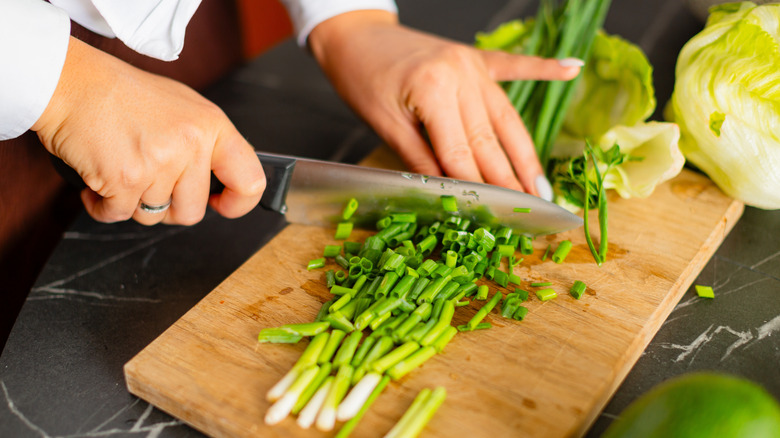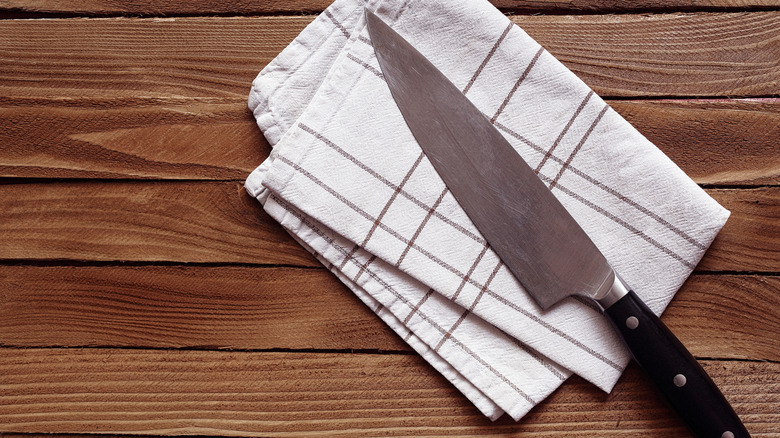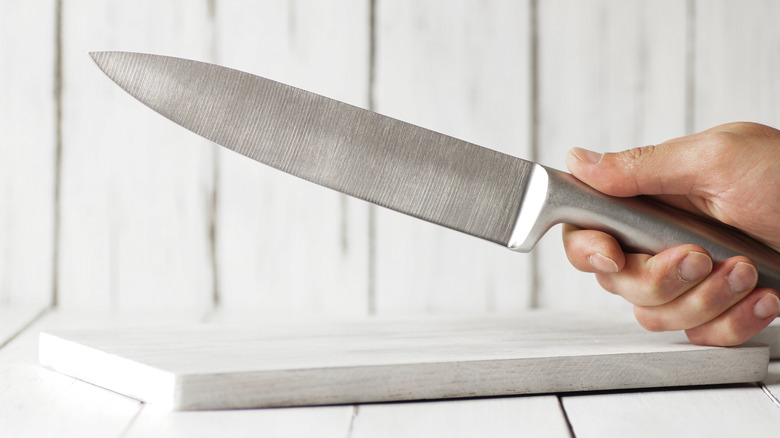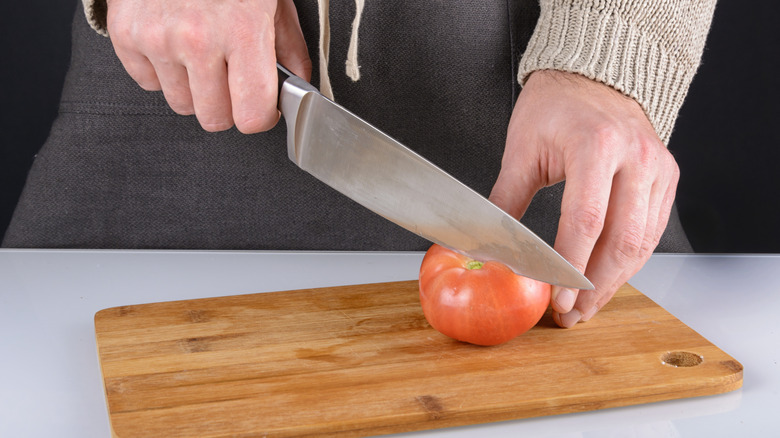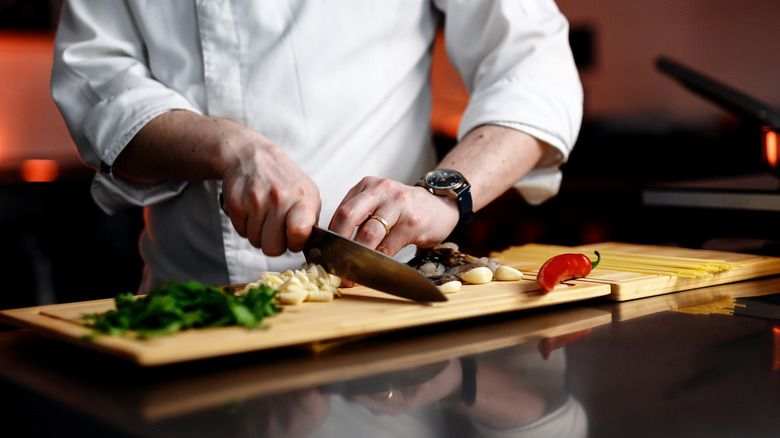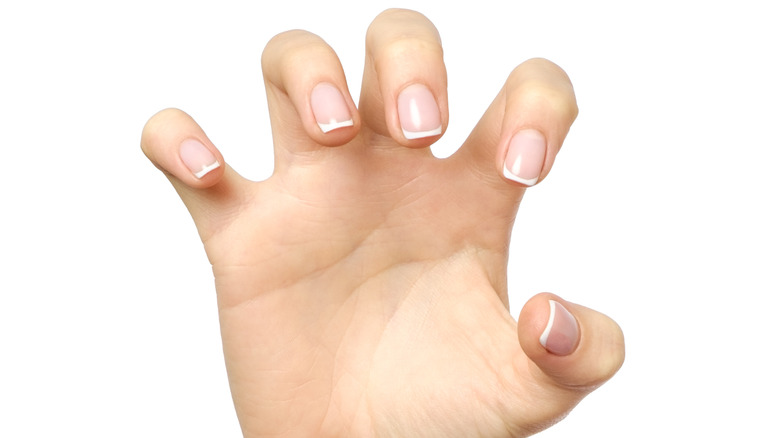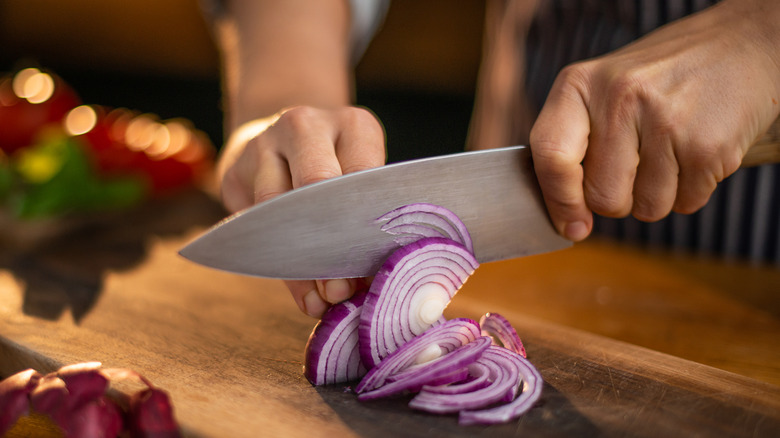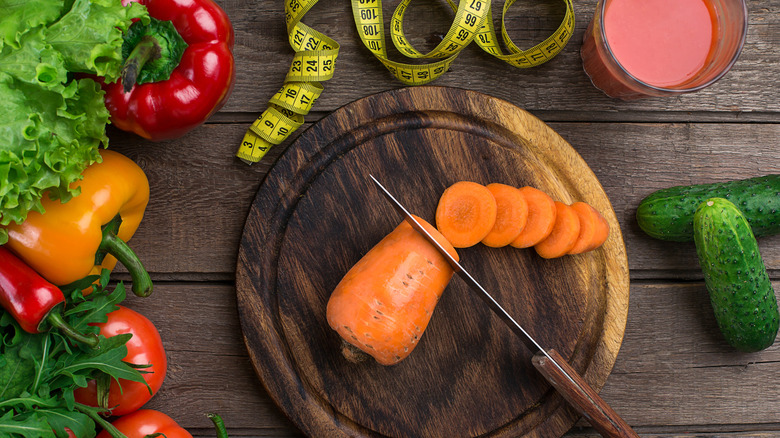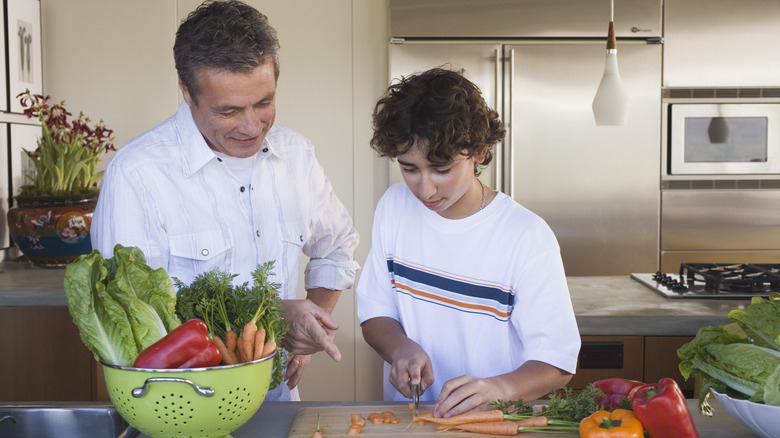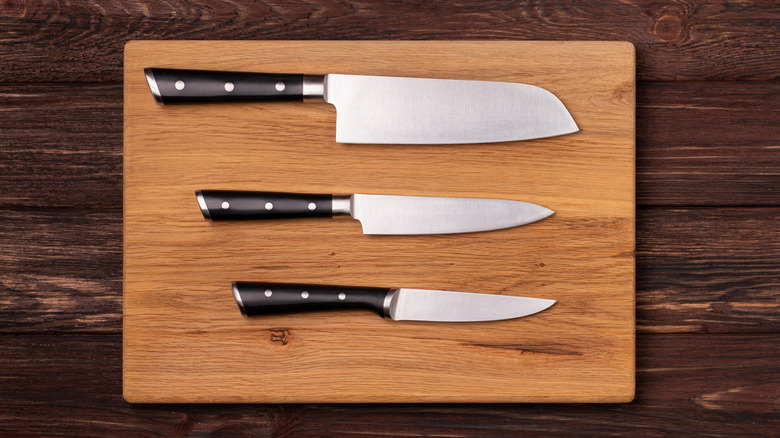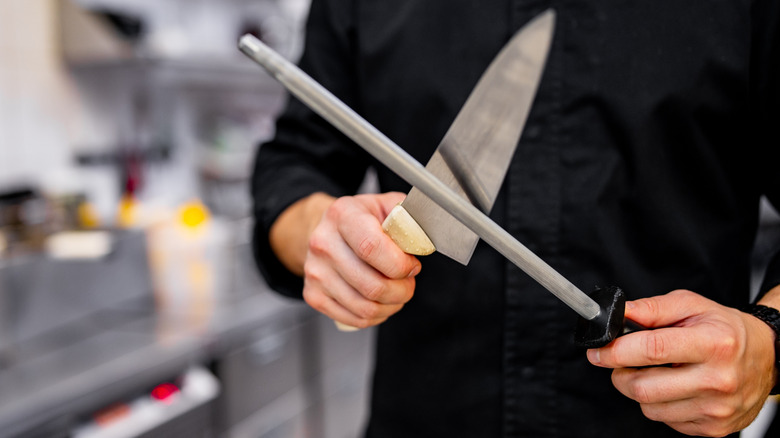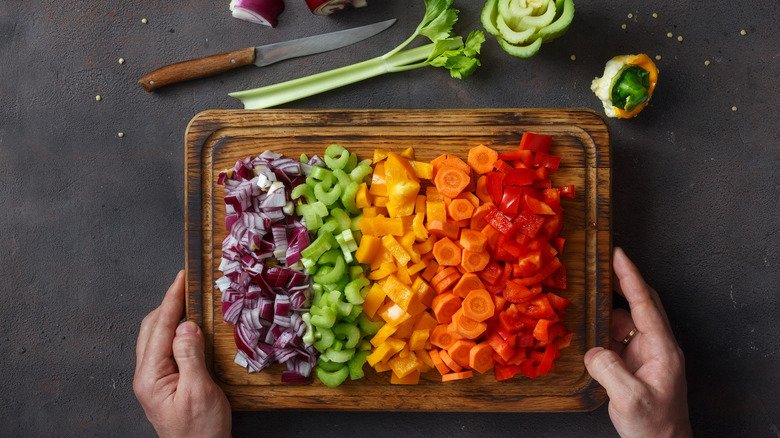12 Tips That Will Instantly Improve Your Knife Skills
So, you want to improve your knife skills in the kitchen, eh? A wise move. Whether you aspire to be a performing hibachi chef, aim to impress your roommates who just want to order takeout all the time, or just want to be a better cook who can prep food faster and more efficiently, it's a fundamental ability to possess. But there are a number of things you have to know before jumping right in and attempting to julienne a lentil blindfolded.
If there's one type of skill where you don't want to be absent the day it's taught, it's the one that involves what's basically a weapon. Good thing learning helps to eliminate fear, doubt, ineptitude, and gashes. It's time to level up your artistry with a blade, your finesse with a fine point, your know-how with a knife. Here are a dozen tips for enhancing your competence at the cutting board.
Know the anatomy of your blade
You're not going to trust a surgeon who's unfamiliar with a scalpel. Why trust yourself with a knife if you're not 100% sure of its anatomy? Knowing a tool makes for a better tool master. And yes, chef knives have a number of parts to them, not just a blade and a handle.
Moving from back to front, there's the tang, which is the metal part of the blade that stretches into the handle and emerges at the end — if it's a full tang that is, not a half-tang, which stops midway through the handle and is usually unseen. From there we have the handle's butt and the rivets running along its side — almost like round screw-tops — which fasten the handle to the metal. Between the handle and the blade is something called a bolster, used for stability. The spine runs alongside the backside of the blade, opposite the edge (the part you're using to cut), all culminating in the tip, which includes the point.
Each of these parts has a purpose. The point is used for piercing, while the tip as a whole is used for subtler cuts of food. The heel of the blade, right in front of the bolster, is ideal for cutting through dense, strong ingredients like squash or carrots. Even the spine, turned upside down, is great for scraping.
Choose the right grip
Grip is important for many activities: bull riding, free-climbing, pickleball, eating pickles (hey, they're slippery). But when it comes to having deft knife skills, grip is fundamental – for both effectiveness and safety. In general, there are two ways to handle a knife properly, each with its own advantages depending on the prep situation.
The first, and most instinctive, is the hammer grip, also known as the handle grip. Imagine you just completed a major business deal with your knife. Give it a nice, firm handshake by wrapping your entire hand around the handle. Ideally, for this grip, you're working with a handle that has a slight arch or bulge to it. Although it's a secure, non-strenuous way to hold a knife, the hammer grip often won't allow for exactitude and accuracy. It's an old-school power forward, not a slick point guard.
If it is precision and smoothness you're going for, then the pinch grip is the way to go. This is where knowing the anatomy of your knife comes into play. To perform the pinch grip, which is the best way to hold small knives, you want to pinch your thumb and forefinger right above the bolster (it can be more difficult when using a knife without a bolster). This will allow you to chop in a comfortable rocking motion, where the blade is doing the work, and generating force isn't necessary. Pros like this grip for its reliability when mincing, chopping, and carving out precise cuts of food.
Make sure your blade is sharp
A dull knife is actually more dangerous than a sharp one. Keeping your blades sharpened makes cutting smoother and easier, putting you in more control and therefore safer. A dull blade on your knife causes you to cut with forceful, jarring motions, which not only makes for sloppy chopping but it'll eat away at your stock of Band-aids and Neosporin.
Now, how often do you need to sharpen your knives? Well, if you're serious about being a knife ninja (aka a ninja) you'll want to get your set sharpened every few months. You can get these done at some kitchen supply stores, knife sharpening services or trucks, or a dude in the neighborhood smithing out of his garage (maybe get some local feedback on this guy first).
As far as daily maintenance to prolong your knives' sharpness, always use a knife block. Don't just toss them in the drawers. The wood preserves the edges much better than a bunch of other silverware. Also, soap, water, sponges, and elbow grease are a knife's besties. Avoid the dishwasher. The combo of moisture, detergent, and heat will do a number: specifically by eroding the handle, causing rust, and blunting the blade's edge.
Slow down to practice so you can speed up your technique
Yes, chopping fast is an impressive thing. It can get you Instagram followers, YouTube views, and the belief you have a genuine superpower. And although it's probably cool to feel like one of the X-Men (except for Cyclops, who would want that?), slow down. Like literally. Slow. Down. Your. Cutting. Just like the proverbial crawl before the walk, speed can only come after technique is mastered – which may sound like a Wu-Tang Clan song sample except it's true. (Wait, of course it's true. It's Wu-Tang!)
But how is mastery attained? Deliberate repetition. Focusing on proper execution, again and again, over and over. You're not in a rush, and if you are, your dinner guests will just have to be patient. Getting technique and precision down not only leads to safer cutting – which is one less blockade to concentration — but consistency. Practice enough in this way, and your abilities can become practically automatic. This would be where someone calling you a robot is actually a compliment.
Master the claw grip with your off-hand
The claw grip. It may sound like a professional wrestler's finishing move. What it is, really, is a crucial method for involving your other hand in the augmentation of your knife skills. Your non-knife hand plays an important role, supporting your dominant cutting hand. Think of it as the Paul Giamatti of your two paws. (No one is stopping you from making a Paul Giamatti hand puppet, by the way). Mastering your off-hand as a guide and helper will improve your overall cutting output and abilities. This is where the claw grip comes into play.
As laid out in the very name, the claw grip starts by making a claw shape with the hand that isn't holding the knife. Hold it outward first, like you're threatening someone with it (but don't really). Then place your fingertips onto the food you're cutting, perpendicular to, and resting softly on, the surface. Your thumb is especially significant, acting as the most stabilizing force. Maintaining this position — although it may be uncomfortable at first — gives you control over the food you're cutting. And the in-turned, clawed, fingertips prevents accidents. You can also use your knuckles to help direct and steady your strokes. It's peace of mind for piecing your food.
Add forward motion to your cutting
Cutting straight up and down might seem like a natural thing to do with a knife. Blade up, blade down. Simple, straightforward, right? It's why Isaac Newton invented gravity. But in actuality it's an amateurish way to prepare food. You don't want to massacre the poor ingredients, they're already going to be devoured and boiled in stomach acid. No need to add insult to injury. Let's give these nourishables the dignity they deserve.
Instead of vertical hacks, a more circular, forward motion with your knife ensures professional-level cuts – best for attaining thin, clean slices of meat, fruit, and veggies. You want to create a rocking movement with your cuts, starting from closer to your body and moving it subtly away from you when slicing through. Just remember this knife choreography: forward, down, back; forward, down, back; forward, down, back. Use as much of the blade's length as possible going through the food. Take your time when rehearsing this and, before you realize, you're going to look like you really know what you're doing in there.
Measure what you cut
Great technique can actually be easy to overlook. When one has expert-level skills, their production is often seamless and steady. Whereas someone who's terrible at a thing stands out way more — mostly because of hilarity. But the truth is, uniformity and consistency are the outward signs of elite technique, especially when it comes to knife handling. Sophisticated cuts like batonnet or julienne or paysanne are defined by exact measurements. Learning these styles, and their metrics, is a big leveling up.
Dicing alone has three different sizes, all separated by roughly ½ inch. When you get to julienne and brunoise cuts, we're talking in the ⅛ inch range, and fine julienne is half that size. If you think you can pull all that off without repetition and analytics, you might want to have the ER on speed dial.
In short, keep a little ruler or measuring tape in the kitchen. As you practice your knife craft and expand your skill set into highly refined cuts, keep close track of your output. Guests might not know if you're off ¼ inch on your tourné. But you will. And when you're trying to achieve greatness, that's all that matters.
Be present mentally
There's a reason pro athletes are counseled by sports psychologists as well as their coaches. The mental strength is directly connected to the physical prowess. A place kicker can nail a thousand field goals in practice, but if they don't have the right focus during the moments it really matters, they're set up for failure. Knowing how to concentrate can not only bring tactile improvement, but a deeper sense of meditation and creativity in your work. When all this comes together, along with an intelligent approach, it's called flow. It's the goal of any craftsperson or artisan — be it a novelist, a sculptor, an architect, or a cook.
You can be an artist with a knife, but it takes a cerebral equanimity as much as anything technical. If you can find psychological fulfillment while bossing the cutting board, it's going to show in the food you produce, the all-important end product. And the fact that mental commitment is a skill in itself, means it can be disciplined and improved. Remember: A knife is only as effective as its wielder.
Maintain good body posture
It's not only your hands you should think about when trying to improve your knife skills. Proper body posture is equally as important. It allows you to find comfort, precision, safety, and assurance at the cutting board, all while giving your hands the best opportunity to do their thing.
You want to start with placement. First of the cutting board itself, which should be slid all the way to the edge of the surface you're working on so that you're directly over it. It's important for your cutting board to stay firmly in spot while you work, so a lot of cooks place a wet towel or paper towel underneath the board to maintain that stability. Second is the placement of the food you're cutting. Although aesthetically pleasing perhaps, it doesn't have to be directly in the center of the cutting board. Place the ingredient anywhere you like as long as you're able to keep your body perpendicular to the board, your arms set comfortably, and you're avoiding any unnatural angles.
Use the proper tool for the purpose
How about, instead of an Allen wrench for building that Ikea side table, you use a bowling ball. Or eating cereal with a monocle instead of a spoon? For every task there is its attendant tool. For every way of cutting up food — chopping, slicing, mincing, peeling, etc. – there is a knife that goes with it. Knowing how to use each different kitchen knife is the first step to being an all-around slicing star.
Choosing the right chef's knife is vital, as it's the one you'll be using the most and that can take care of your day-to-day slicing, dicing, and chopping. The utility knife is basically a smaller version of the chef's knife, bringing a bit more precision into the fold. Then you have your paring knife, which is even smaller, can come with different blade contours, and is made for exacting cuts.
There are also serrated blades such as bread and tomato knives, designed to cut through more cushiony food, like a saw, without smushing said food into viscous oblivion (note: serrated knives do require their own type of sharpening). Carving and boning knives serve purposes clearly outlined in their names, while the good old cleaver will cut unceremoniously through meat and bone.
Hone your honing skills
When you think of an old-timey butcher, or a village tanner in your medieval fantasy RPG, you probably picture them forebodingly sharpening their blades with that long stick thing. Well, that's not just some stick thing, and they are not sharpening anything. What they are doing is "honing", also known as "steeling." And, yes, sharpening knives is of the utmost importance to any ambitious slice-master. But honing — or realigning — your blades is just as imperative to optimizing your knife collection and, therefore, knifework.
After you get your hands on a metal honing rod and you're ready to use it, place it in your off-hand, gripping under the small guard at the top of the handle to avoid having an unwanted rendezvous with the blade. You then want to slide your knife at a slight angle against the steel rod repeatedly, alternating the sides of the knife to get an even alignment. Never do this at a speed in which you're uncomfortable. The more you do it, the faster you'll become anyway. And honing should be a consistent activity. Professional cooks always have their steel nearby, for this very reason. And who better to emulate than the experts?
Practice with the right food and recipes
The old "practice makes perfect" — actually, that idea never gets old. It's still as new as ever, and especially true for knife skills. But how to practice kitchen blade craft the right way? Shadowboxing in the moonlight? Running laps around the track? Playing chess against yourself? Well, no, because none of those things have to do with a knife. What does, however, is finding ideal food and recipes that force you to practice knife-work.
Essentially, you want to push yourself to improve, and this requires selecting ingredients and meals that require you to do all kinds of cutting, such as julienning, ribboning, etc. Some ideal foods with which to stabilize your chopping skills are carrots, potatoes, apples, and celery, while peeling mushrooms, cucumbers and even pineapple are great for paring practice. Look up recipes, challenge yourself. The food can always still be eaten, so don't worry about messing up. And remember: You've got this.
